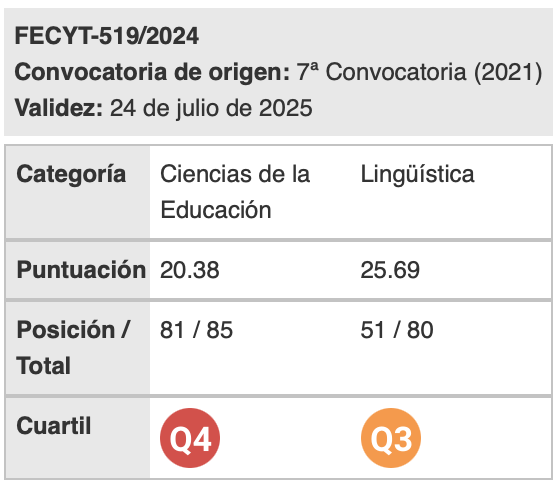V-interESP - Utilização de Vídeos para Melhorar a Experiência de Aprendizagem dos Estudantes ESP: Ensino e Investigação Conjunta Internacional
Palabras clave:
vídeo, ESP, ensino, comunicação, motivaçãoResumen
Tendo como principal objetivo rever abordagens e dinâmicas de ensino e aprendizagem no domínio do Inglês Para Fins Específicos, neste artigo descrevem-se as fases de planificação e implementação da primeira iteração do projeto V-interESP. Este projeto de investigação conjunta contou com a participação de alunos e docentes da Lituânia, Portugal e Sérvia, tendo com principais objetivos contribuir para a compreensão do papel da tecnologia digital, e mais especificamente dos vídeos, na promoção e enriquecimento das experiências dos alunos que frequentam aulas de Inglês para Fins Específicos; e promover a criatividade e a comunicação intercultural neste domínio. Desta forma, tendo por base um questionário inicial aplicado aos alunos, para além da descrição da implementação do projeto, são apresentados resultados preliminares quanto ao perfil dos participantes e as suas percepções, designadamente relativamente ao potencial da utilização de vídeos na aprendizagem de línguas e enquanto fator motivacional e de promoção de competências comunicativas e da criatividade.
Descargas
Citas
Bonsignori, V. (2018). “Using Films and TV Series for ESP Teaching: A Multimodal Perspective.” System 77, 58–69.
Burkšaitienė, N., & Selevičienė, E. (2017). “University and College Teachers’ Attitudes Towards Web 2.0 Technologies and Their Use For Teaching English for General and Specific Purposes.” Journal of Teaching English for Specific and Academic Purposes 5(2), 231–40.
Dashtestani, R., & Stojkovic, N. (2016). “The Use of Technology in English for Specific Purposes (ESP) Instruction: A Literature Review.” Journal of Teaching English for Specific and Academic Purposes 3(3), 435–56.
Dikilitas, K., & Duvenci, A. (2009). “Using Popular Movies in Teaching Oral Skill.” Procedia-Social and Behavioral Sciences 1(1), 168–72.
Dudley-Evans, T. (1998). “An Overview of ESP in the 1990s.” In The Japan Conference on English for Specific Purposes Proceedings, 5–11.
Duquette, G. (1995). Second Language Practice: Classroom Strategies for Developing Communicative Competence. Multilingual Matters.
Early, M., Kendrick, M., & Potts, D. (2015). “Multimodality: Out from the Margins of English Language Teaching.” Tesol Quarterly, 447–60.
Godwin-Jones, R. (2011). “Emerging Technologies Mobile Apps for Language Learning.” Language Learning & Technology 15(2), 2–11.
Gong, Q., Kawasaki, K., Yeung, L., Zhang, G., & Dobinson, T. (2019). “Students’ Perceptions of the Use of Video Recording in Additional Language Oral Assessments.” In Literacy Unbound: Multiliterate, Multilingual, Multimodal, 133–52. Springer.
Harmer, J., (2001). The Practice of English Language Teaching. Longman.
Hendron, J. G. (2008). RSS for Educators- Blogs, Newsfeeds, Podcasts, and Wikis in the Classroom. ISTE.
Hosseinpur, R., Nevisi, R., & Bahrani, S. (2018). “The Impact of Sequence Map, Answering Question, and 3-2-1 Techniques on EFL Learners’ Summary Writing Ability.” Journal of Teaching Language Skills 37(2), 125-167.
Hutchinson, T., & Waters, A. (1987). English for Specific Purposes: A Learning-Centered Approach. Cambridge: Cambridge University Press.
Ilin, Gülden, Kutlu, O., & Kutluay, A. (2013). “An Action Research: Using Videos for Teaching Grammar in an ESP Class.” Procedia-Social and Behavioral Sciences 70, 272–81.
Jarvis, H. (2009). “Computers in EAP: Change, Issues and Challenges.” Modern English Teacher 8(2): 51–54.
Jenkins, H, Purushotma, R., Weigel, M., Clinton, K., and Robison, A. (2009). Confronting the Challenges of Participatory Culture: Media Education for the 21st Century. MIT Press.
Kaiser, M. (2011). “New Approaches to Exploiting Film in the Foreign Language Classroom.” L2 Journal 3(2).
Maley, A. (2018). “Creative Materials: An Oximoron?” In Creativity and Innovations in ELT Materials Development: Looking beyond the Current Design., 74–90. Multilingual Matters.
Marzuki, M. J., and Nurpahmi, S. . 2019. “Using Video Blog in Teachibg Speaking.” English Language Teaching for EFL Learners 1 (1), 13–23.
Milosevic, D. (2017). “Using Video Materials in English for Technical Sciences: A Case Study.” New Developments in ESP Teaching and Learning Research, 15–30.
Plomp, T., & Nieveen, N. (Eds). (2007). An Introduction to Educational Design Research. Netherlands institute for curriculum development. https://ris.utwente.nl/ws/portalfiles/portal/14472302/Introduction_20to_20education_20design_20research.pdf
Selevičienė, E., and Burkšaitienė, N. (2015). “University Students’ Attitudes towards the Usage of Web 2.0 Tools for Learning ESP. A Preliminary Investigation.” Societal Studies 7(2), 270-291. https://doi.org/10.13165/SMS-15-7-2-07
Sherer, P., and Shea, T.. 2011. “Using Online Video to Support Student Learning and Engagement.” College Teaching, 59 (2), 56-59. https://doi.org/10.1080/87567555.2010.511313
Van den Akker, J., Gravemeijer, K., McKenney, S., & Nieveen, N. (Eds). (2006). Educational design research. London: Routledge.
Webb, S., and Rodgers, M..( 2009). “The Lexical Coverage of Movies.” Applied Linguistics 30(3), 407–27.
Yeh, H. (2018). “Exploring the Perceived Benefits of the Process of Multimodal Video Making in Developing Multiliteracies.” Language Learning & Technology 22(2), 28–37.
Zhu, Y. (2012). “Principles and Methods in Teaching English with Multimedia.” In Advances in Computer Science and Education, 135–39. Springer.
Descargas
Publicado
Cómo citar
Número
Sección
Licencia
Aquellos autores/as que tengan publicaciones con esta revista, aceptan los términos siguientes:
- Los autores/as conservarán sus derechos de autor y garantizarán a la revista el derecho de primera publicación de su obra, el cuál estará simultáneamente sujeto a la Licencia de reconocimiento de Creative Commons que permite a terceros compartir la obra siempre que se indique su autor y su primera publicación esta revista.
- Los autores/as podrán adoptar otros acuerdos de licencia no exclusiva de distribución de la versión de la obra publicada (p. ej.: depositarla en un archivo telemático institucional o publicarla en un volumen monográfico) siempre que se indique la publicación inicial en esta revista.
- Se permite y recomienda a los autores/as difundir su obra a través de Internet (p. ej.: en archivos telemáticos institucionales o en su página web) antes y durante el proceso de envío, lo cual puede producir intercambios interesantes y aumentar las citas de la obra publicada. (Véase El efecto del acceso abierto).

Revista de Lenguas para fines específicos is licensed under a Creative Commons Reconocimiento-NoComercial-SinObraDerivada 4.0 Internacional License.























